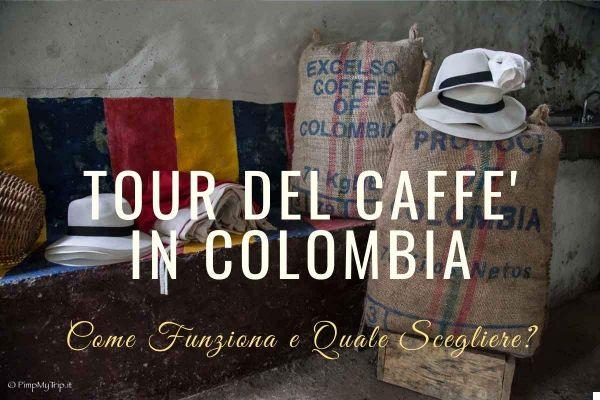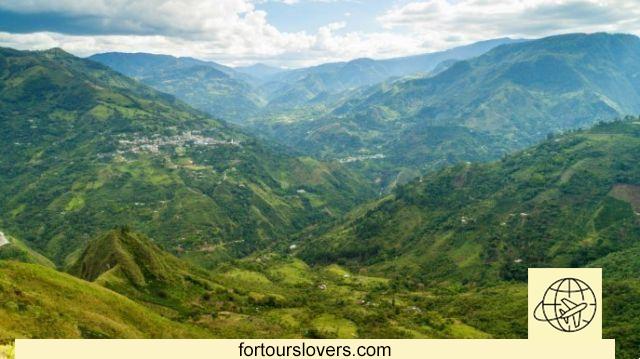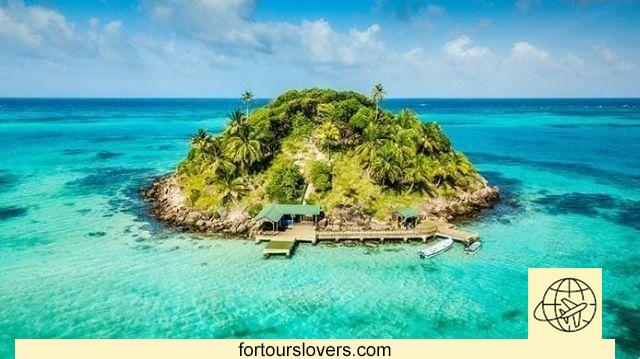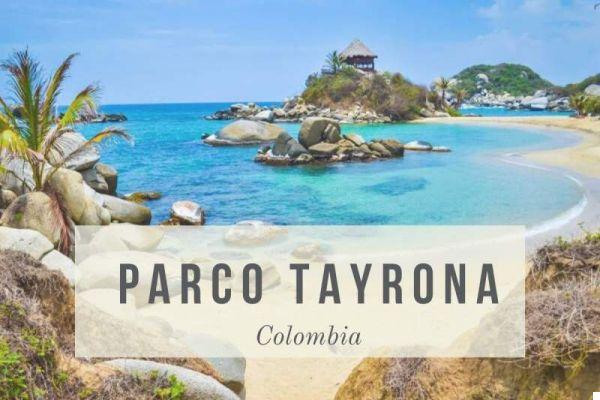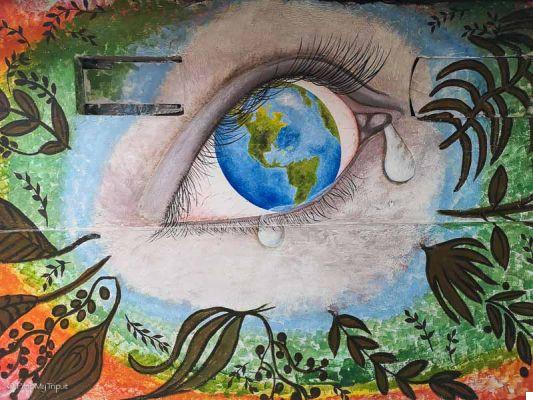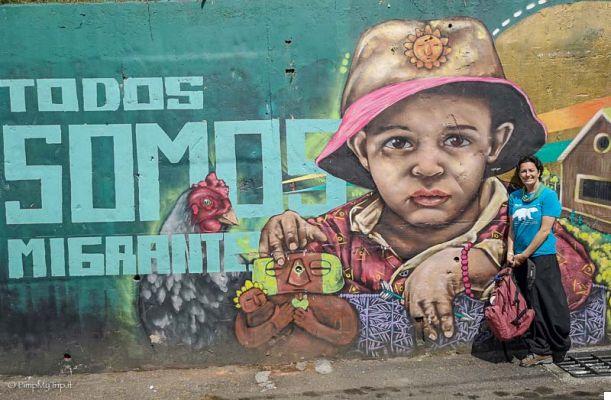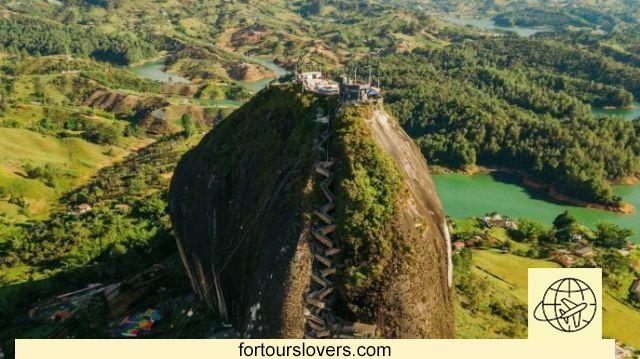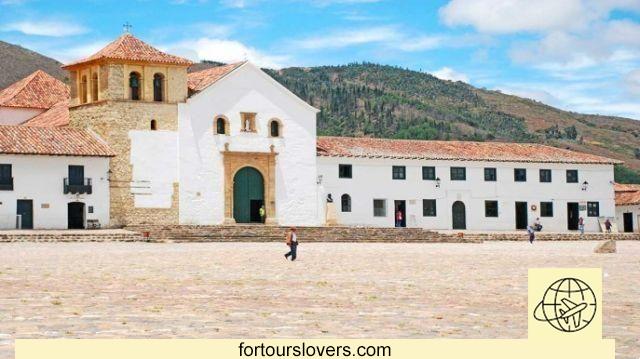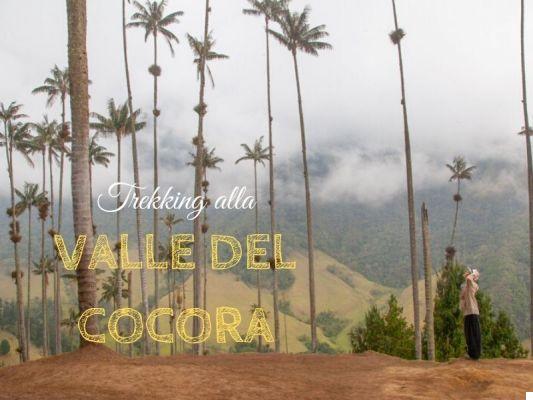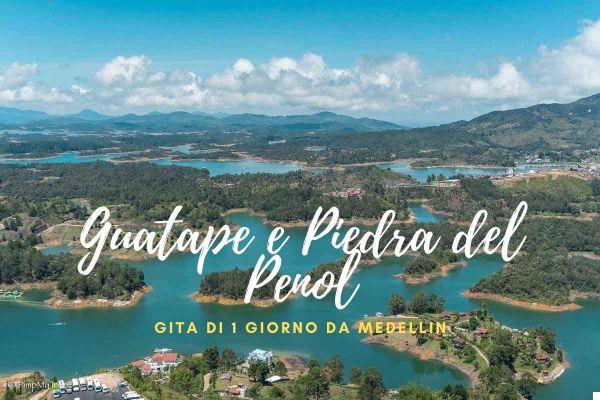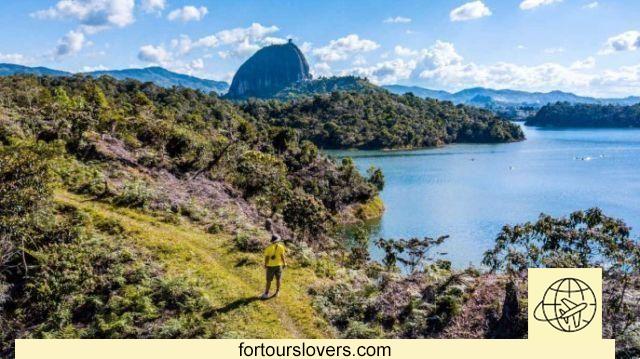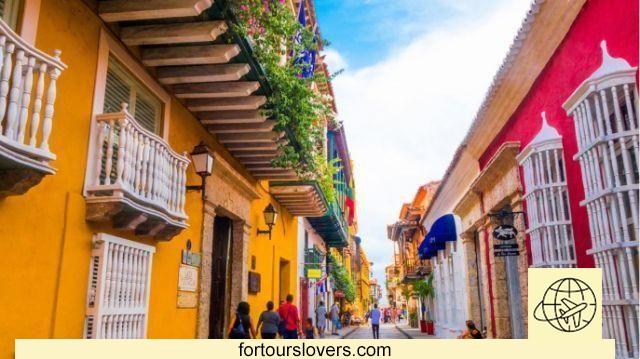There are so many Pablo Escobar tour to Medellin and they are very controversial. The question to ask is whether it is ethical to take part in it or not. Despite this, the demand is always very high, as shown by the numbers.
At the end of this article, in which I will first list the luoghi di Pablo Escobar to Medellin, I will try to tell you the reasons for this debate and also the different opinions of two Colombian inhabitants with whom I spoke about it.
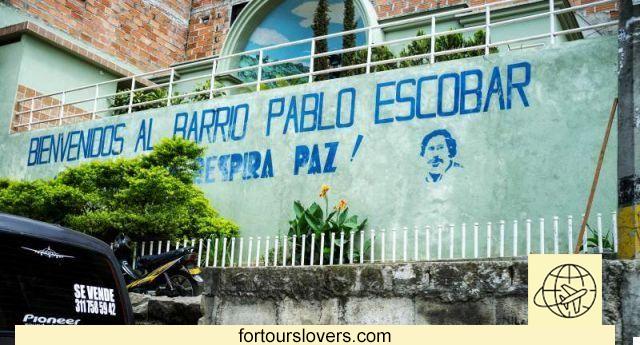
Between the 1993s and XNUMX Pablo Escobar sowed terror and death across Colombia, kicking off that period known as narcoterrorism. The "drug king" and head of the "Medellín cartel" was one of the most feared and dangerous drug traffickers ever.
Today Medellín, his city, still bears vivid memories of that time. There are those who still celebrate it and those who try to forget it: what is certain is that the specter of his controversial figure is still very present in the city.
If you have decided to visit Medellín, chances are you are curious to know more about the history of the famous drug trafficker and the historical period of which he was the protagonist. For this you may want to go in search of the places of Pablo Escobar in Medellín or you would like to take part in one of the many tours offered by the agencies.
Warning! If you are interested in the history of drug trafficking in Colombia and are visiting Medellín, you absolutely cannot miss the House of Memory Museum. I assure you you will not regret it, it is 1000 times better than any Pablo Escobar tour!
So here are Pablo Escobar's places to visit in Medellín (not all of them are included in the tours).
- 1 - The Monaco Building
- 2 - Pablo Escobar neighborhood
- 3 - Virgen de la Rosa Mystica Sanctuary
- 4 - The house in the Los Olivos neighborhood
- 5 - The Cathedral
- 6 - Soccer field
- 7 - Jardines de Montesacro Cemetery
- 8 - Hacienda Napoles
- Pablo Escobar tour: ethical or not? The debate
- The problem of narcotourism
- Final thoughts: to tour or not?
1 - The Monaco Building
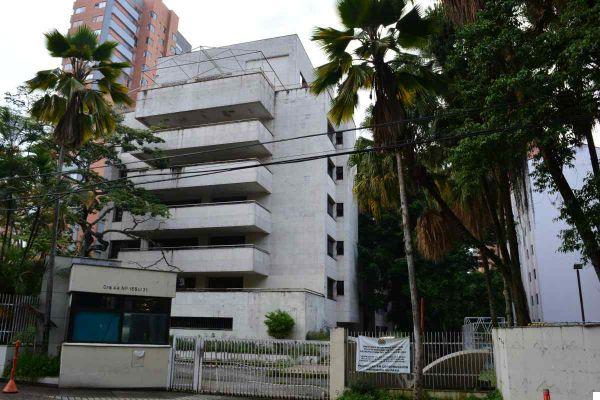
The Monaco building in this old photo. Today it no longer exists so you won't be able to see it.
One of the most emblematic places in Medellín is the place where theMonaco Building, in the neighborhood of El Poblado, one of the most beautiful and richest in the city.
This was the home of Pablo Escobar and his family, but also the place where his enemies (or supposed enemies) were tortured and then killed.
The drug trafficker's "palace" extended over several floors, had a basketball court, a tennis court and a huge garage.
In 1988 the Cali Cartel detonated a car bomb right here and this event marked the beginning of that war between the two cartels that brought death and destruction to the city.
Despite the size of the explosion, the eight-story building that Pablo Escobar had built not only as a home but also as a personal bunker for himself and his family did not collapse.
Escobar was not present at the time of the explosion, but his wife María and their two children Juan Pablo and Manuela slept in the attic. Manuela was injured and suffered permanent hearing damage. One thing about Escobar is certain: he loved his family madly.
It was precisely because of this event that endangered his loved ones that Escobar "declared war" on the Cali cartel, following an ever-increasing escalation of violence.
You will not be able to see the Monaco buildingsimply because it no longer exists: it was demolished in 2019 by decision of the mayor of Medellín Federico Gutiérreze: in its place, in the future, a memorial to the victims of drug trafficking will be built.
2 - Pablo Escobar neighborhood
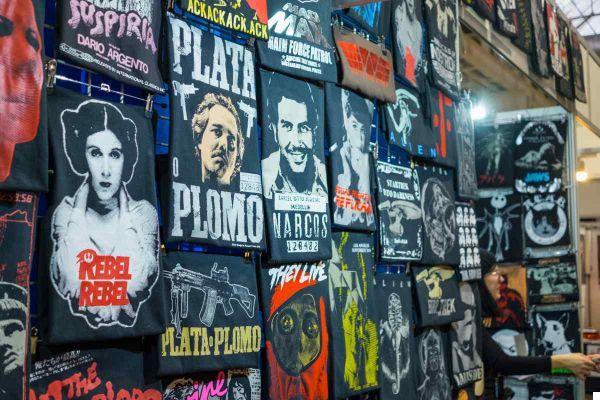
This neighborhood is still strongly linked to the figure of Escobar so much so that it is identified with his name: there are still many people who venerate him as a God here.
The Colombian thug started his career right here and for a long time he used the money coming from drug trafficking for the construction of public works in the city and for the construction of houses that he gave as donations to the inhabitants.
At the time, Escobar liked to wear the nickname Robin Hood of Medellín. In reality he did not do it for his good heart but for two other reasons: the first to facilitate his political career (the redevelopment of the neighborhoods was in fact part of his political plan "Medellín sin tugurios") and the second to ingratiate himself with the inhabitants. local. If Escobar always managed to escape from the police it was in fact because people protected him.
In this area it is easy to spot murals that portray him or writings that remember him and his work. Small shops are doing good business by selling all kinds of gadgets with the face of Escobar, from mugs, key rings, magnets, t-shirts with the words "Plata or Plomo" and so on and so forth.
PRO TIP: one of the places you absolutely must visit in Medellin is there Commune 13. No, it has little to do with Escobar, but it is one of the must-see areas, much more interesting than Barrio Escobar
3 - Virgen de la Rosa Mystica Sanctuary
Pablo Escobar was a very religious man and often went to church and to pray.
One of his favorite spots was the Virgin of the Mystic Rose Shrine, also known as the Virgin of the Hitmen.
It seems, in fact, that the assassins often went here before going to carry out a murder.
4 - The house in the Los Olivos neighborhood
In the western area of Medellín it is located the house where Pablo Escobar spent the last days of his life, now hunted by the police. It was here that on December 3, 1993 Pablo Escobar and his bodyguard Limòn met their death.
The police, in fact, managed to locate their radiotelephone, surrounded the house and after a chase on the roofs of the surrounding houses, they shot the drug trafficker to death. At least, this tells the official story.
In fact, if you go on a tour or get the chance to speak to a guide, you will be told how Escobar almost certainly committed suicide so as not to fall into the hands of the police.
Precisely because of the controversy, the house of Los Olivos it is no longer included in the Pablo Escobar tours, so if you want to see it you will have to go there alone.
5 - The Cathedral
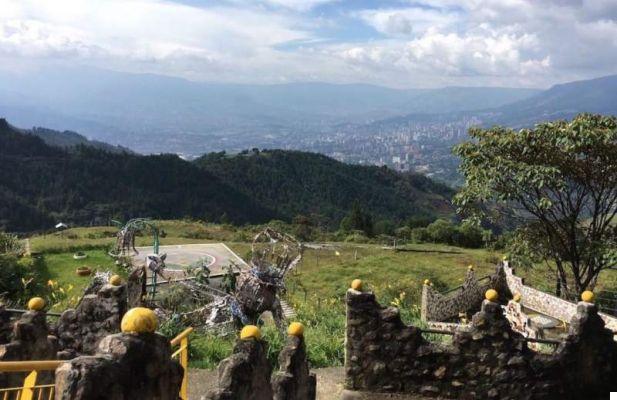
Another of Pablo Escobar's places in Medellín is The Cathedral, the luxury prison where he was held for a few months before escaping in 1992.
La Catedral is located near Envigado, on a high mountain surrounded by lush meadows and forests, not too far from Medellín.
It is no coincidence that this place was chosen by Escobar to build his prison: the elevated position allowed an excellent view of the entire city and the city airport.
From here Escobar continued to manage his drug trafficking from above by controlling the planes laden with drugs and dollars that departed and landed.
The period that Escobar spent in La Catedral is probably the most shameful in the history of Colombian drug trafficking as the prison was mostly a "resort".
More than a prison, this place in fact resembled a palace: there were game rooms, a swimming pool, a bar, a fitness center, whirlpools and spacious and comfortable rooms.
Today La Catedral is a Benedictine monastery and can only be visited outside.
6 - Soccer field
Another stop on Escobar's tours in Medellín (inserted when the house in the Los Olivos neighborhood was excluded) is one of the football fields built during the time he was trying to pass himself off as a benefactor.
This camp was famous at the time for its visionary design and here Escobar gave a speech in an attempt to enter Colombian politics.
Although many say that Escobar built sports fields to "keep the young kids of the city out of the loop", the guide will tell you that the purpose was not exactly beneficial.
At the time, in fact, children under a certain age were not prosecuted by law and the camps were actually nurseries where young people could be recruited for drug trafficking, generally as couriers or lookouts.
7 - Jardines de Montesacro Cemetery
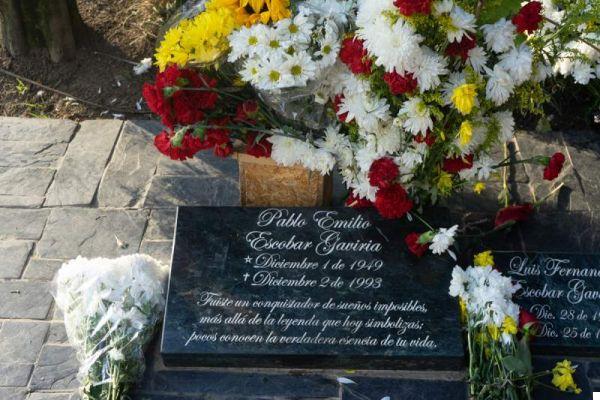
Another stop to reach if you are interested in the figure of Pablo Escobar is the Montesacro Gardens Cemetery. Here are buried the remains of the most famous drug trafficker of all time and his family.
Even today many people come here to bring flowers and pray. The tomb of Pablo Escobar is second most visited in South America after that of Evita Perón in the Cementerio de La Recoleta in in Buenos Aires.
8 - Hacienda Napoles
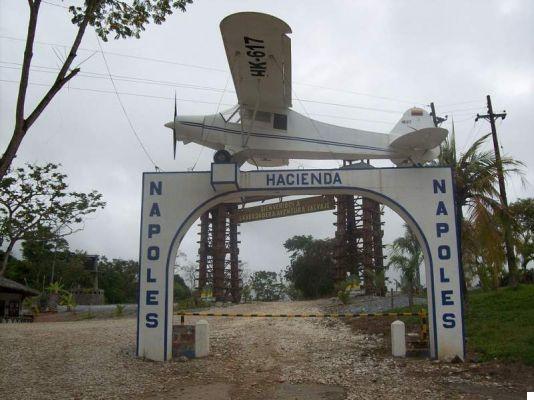
Photo repertoire from Wikipedia
Outside the city, about 3 hours by car, there is one of the most emblematic and best known places of the figure of Pablo Escobar: thehacienda Napoles.
This was not only the place where the drug trafficker came to relax with his family, but it was the real headquarters of the Medellín cartel. Here meetings were held, decisions were made, the planes loaded with cocaine left for the United States and landed here on their return loaded with dollars.
The estate covers 3000 hectares and was bought in 1978 by Pablo Escobar and his cousins Jhonny Bedoya Escobar and Luis Bedoya Escobar. The embellishment works began immediately.
In the end, inside, there turned out to be a series of buildings with dozens and dozens of rooms, long streets, 6 swimming pools, 27 artificial lakes, a petrol station, an airstrip, some heliports and a series of hangar.
Inside the Hacienda Napoles there was also an exotic garden with palm trees and a series of stables with horses. Pablo Escobar even added a bull ring and a large zoo with exotic animals including giraffes, zebras and hippos. Already at the time it was possible to use cars, jet skis and bicycles inside to make real tours of the estate.
After his escape from the Cathedral, the Hacienda Napoles was seized by the armed forces, but with the death of the drug trafficker it ended up in a state of neglect. The properties were looted and squatted and the animals began to roam free.
Even today the hippos that Escobar had imported from Africa live in the surrounding rivers, giving many problems to the ecosystem.
Only in 2006 this place became state property and today it has been transformed into a huge theme park.
Pablo Escobar tour: ethical or not? The debate
There has been a lot of talk and still talk about whether it is ethical or not take part in a tour of the places of Pablo Escobar in Medellín.
Giving an answer is difficult and this is certainly not a topic that can be dealt with in a few lines.
However, I will try to explain what I understood or try to make you see it also from a different point of view.
First of all: as soon as you arrive in Medellín you will realize, as happened to me, that the Paisas generally do not like to pronounce the name Pablo Escobar. And many of them get angry when they hear that foreigners want to take part in one of these tours.
I understand them. The story is still recent and it is a very painful and always open wound: many inhabitants have lost a brother, a parent, a friend due to the Cartel and the war on drug trafficking and they would like it not to be talked about anymore.
In Medellín, many tour companies offer Pablo Escobar tours, some of them in the past went so far as to offer the opportunity to meet Pablo's brother Roberto, or offered guided tours from Popeye one of Pablo's (now dead) hit men .
Generally these tours are called "no name tours" in the sense that that name cannot even be pronounced.
This was another reason for criticism as in these tours the figure of Pablo Escobar was told more as a pop icon than as a killer and in addition the tours funded the people who had contributed to the years of terror with him.
Today this is no longer the case. After various discussions these tours have been canceled and the ones that are on today are tours led by professional guides who have nothing to do with the "drug cartel".
But the real question in all of this is: is the country's narcotics-steeped history something that should be told, however much it is in demand?
During my trip to Colombia I had the opportunity to speak often with guides, for example during the tour a Guatapè e Piedra del Penol, or during the tour of the Comuna 13. The guides are also debated on this topic.
Some guides and agencies they completely dissociate: for them Colombia should not be seen as the country of drug trafficking, but rather as the country it is today.
These guides think the country should focus on its other strengths besides narco-history.
These guides argue that the word "cartel" is long gone from the lives of Colombian citizens and that the inhabitants want people to see their country as something else, not as a drug dealer.
While tourism-wise they recognize the value of entertainment and production of the Netflix series Narcos, they firmly believe that it is bad for the country to sell an image of Colombia that, to this day, no longer exists.
Other guides, on the other hand, think differently: in fact, the demand for these tours is so high that they realize that it generates an important induced that brings wealth.
But not only that: these guides are firmly convinced that knowing history is one of the fundamental keys to better understand Colombia as the country it is today and to fully understand the enormous scale of the change that Colombia was able to do within a few years.
They see the period of drug trafficking as a part of their history of yesterday to better understand Colombia today and not like a stain that they wear and have to be ashamed of.
A phrase that a guide told me has stuck with me and it is this:
"I don't think doing these tours is exploiting people's pain because we are a country with strong citizens who can endure many situations and anything that can make us weak actually makes us stronger, because our history has forged us, made us understand who we really are and made us what we are today "
The problem of narcotourism
The problem with Pablo Escobar's tours is just a nuance of a much bigger problem.
This is the problem with TV series like Narcos on Netflix: they can create in people's minds the idea of a Pablo Escobar as a hero, a hunted outlaw, a friend of the people and one who led the good life.
It seems truly incredible, but I swear to you it is reality: many tourists visit Colombia today not to get to know the country, but to experience for a few days the thrill of living like a drug trafficker, among drugs, clubs, women and money.
Unfortunately, drug tourism is an opportunity not only to learn about the history of Colombia, but also to open the doors to the Pablo Escobar fanboys who come here to perpetuate their warped perspective of the drug lords.
Final thoughts: to tour or not?
I make a mea culpa: personally after seeing the Narcos series, I began to feel a very strong curiosity.
I have read so many books about Colombia, including some on the story of Pablo Escobar, before leaving.
Do not take me badly because this curiosity was not entirely negative: it was in fact due to wanting to know more about that period of Colombian history and not because I was fascinated by El Patròn or his lifestyle and what he did (and there more would be missing).
But not only that: personally I firmly believe that "knowing" also means having awareness and I firmly believe that knowing history helps to prevent certain horrors from happening again in the future.
Sometimes we travelers are like sponges that feel an urgent need to absorb water. We have an unstoppable desire to know and see with our own eyes.
Let's be honest: you can read all the history books, watch all the documentaries and news reports, but you can't really understand the extent of what happened if you don't physically visit the places where the story was lived. If you don't put your feet on the same ground. If you don't touch the same walls with your hand. If you don't "see" the places with your own eyes. Only then do you get a sense of reality and only then can you fully understand the atrocities that have been committed.
I also believe that condemnation and curiosity are not mutually exclusive: If visitors are not allowed the opportunity to truly learn about Colombia's grim past, they run the risk of creating the opportunity for false narratives that almost lead to the idolization of terrorists as heroes.
I'll give you a very classic example: I was convinced that Pablo Escobar really built soccer fields because he cared about his people and I thought that basically not everything he did did it only for himself and his own advantage.
Nothing more wrong than that.
Only thanks to the tour did I discover that the camps were places in which to enlist and retain children who first became "lookouts" and then "couriers". And if they were particularly ruthless, hit men.
All this I learned only because I took part in the tour, otherwise the stories tell another story.
Going on a Pablo Escobar tour will probably be the only way to get to know the “true” story told by a Colombian since in no other way will you have the opportunity to talk about Escobar with a “local”.
I assure you that listening to the true story experienced by a local has nothing to do with the Escobar seen in Narcos (played among other things by Wagner Moura, one of my favorite actors, already protagonist in "Tropa d'Elitè ”Set in Brazil) or by Benicio del Toro.
On the other hand as guests in this country, I feel that we must be respectful of the wishes of the locals and respectful to refrain from engaging in activities that seem to glorify Escobar.
In the end, I firmly believe that the key component of the matter is the education: educating tourists that there is more to Colombia than cocaine, drug lords and coca factories hidden in the forest.
Then a is taking part in these tours ethical or not? Perhaps instead of seeking an answer to this question at all costs, the real key is the cultural sensitivity.
If you are planning a trip to Colombia, remember that the Escobar tours are just a small facet of the deep and colorful culture of this beautiful country.
So if your curiosity gets the better of you and you MUST join a Pablo Escobar tour, then be responsible: find a reliable guide who will tell you the facts and not just a sensationalist story.
Try taking a Pablo Escobar tour in a small group of just two or three people. And please, avoid silly smiling selfies in front of the places you are going to visit.




